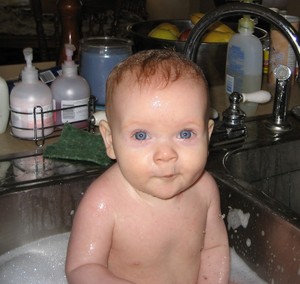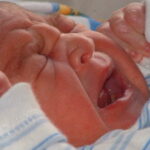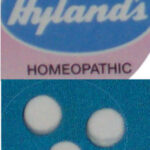Many parents wrongly think that their breastfed baby is constipated. This false thinking may be attributed to one of the following reasons:
1. Parents do not understand the difference between constipation and infrequent stools. Constipation is defined as hard, dry stools. Constipation is not infrequent, soft stools. Most babies will grunt and visibly strain to pass stools. This is not an indicator of constipation either.
2. After 6 weeks of age, an exclusively breastfed infant’s stooling pattern changes. Up until this point, a breastfed infant generally exhibits the gastro-colic reflex, meaning he tends to have a movement several times a day, often after each feeding. After the early weeks, his intestinal tract develops more, and this reflex subsides. After this point, it is perfectly normal for a breastfed baby to go more than a week between bowel movements.
The truth is the exclusively breastfed baby is RARELY constipated. Here’s why:
– Breastmilk is a natural laxative.
– Breastmilk is easy to digest.
– Several types of healthy bacteria live within the bowel of a breastfed baby. This bacteria enables the baby to digest otherwise indigestible proteins in milk.
– Further, it actually makes stools softer and easier to pass.
– In the early months, the breastfed baby has higher levels of a hormone called motiline that increases the frequency of movement of the bowels.
When solids are introduced or supplemented with formula, there is an increased chance of constipation. Common culprits of constipation include formula, rice cereal, and bananas. Natural stool softeners may include prunes, apricots, peaches, peas, and green beans. Keep in mind that all babies react differently to foods: what may help one child may not help the next. What constipates one child may not bother the next.
There are several natural means of relieving the constipated baby.
– Offer the breast frequently and often, as mentioned above, breastmilk acts as a laxative.
– Back off on solids.
– Massage your baby’s tummy. Start at your baby’s belly button and work outwards in clockwise circles. Use oil or lotion to let your fingers glide over the skin. I recommend natural oil like Safflower Oil. If the child visibly does not enjoy the massage, then stop. A great reference for infant massage is Infant Massage–Revised Edition: A Handbook for Loving Parents by Vimala Schneider McClure
-Move your baby’s legs in a cycling motion. Lay your baby on his back and hold your child’s legs and gently move them in quick cycling movements. This moves the stomach muscles and also applies pressure on the intestines.
– Give your baby a warm bath. This helps him to relax his anal muscles.
It may be wise to try these methods before trying more invasive techniques. Older treatments such as rectal stimulation with a thermometer or giving the child a mixture of light corn syrup (Karo Syrup) in water are truly not the best suggestions. Rectal stimulation can actually damage the anal tissue, and corn syrup gives unhealthy amounts of sugar to the child. Juice is also not recommended for children under the age of two months. When natural methods are not working, suppositories can be very effective, but should be given under the advice of a doctor.
If your child is constipated, monitor him for the following signs of concern. Call your pediatrician if these signs persist:
– Hard stools that are pebble-like. Or, in the exclusively breastfed baby, stools thicker than peanut butter.
– A hard, swollen, or distended abdomen.
– Obvious pain and crying when trying to pass a movement.
– Fever.
– Blood in the stool.
To summarize, before parents determine that their baby is constipated, they need to understand that infrequent stools are not the same as constipation. Constipation refers to hard, dry stools. Infrequent stools can be perfectly normal. However, if it persists and natural methods are not relieving the problem, it may be wise to consult a pediatrician.









